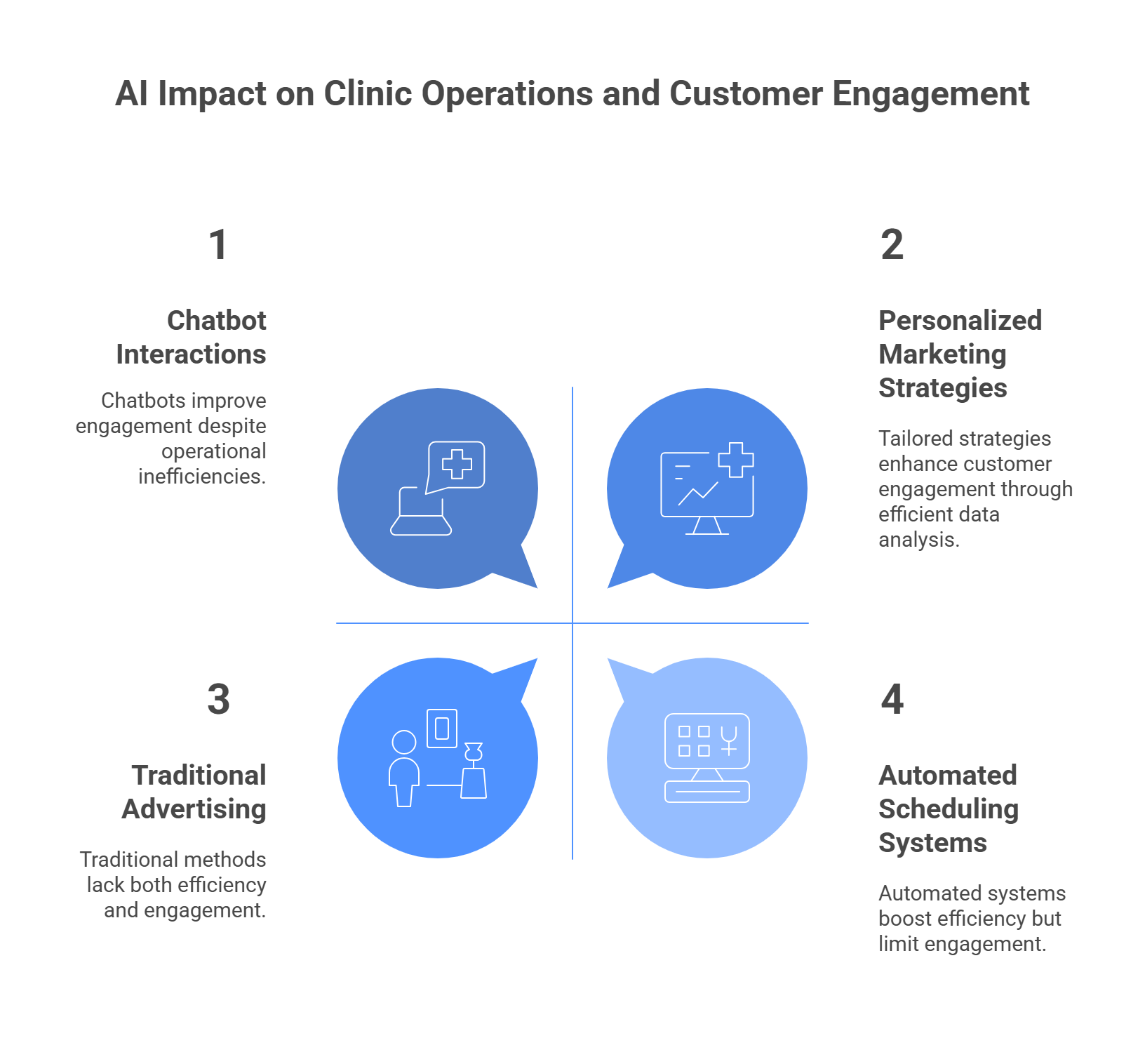
How artificial intelligence agents help medical and beauty clinics attract customers?
The way patients find and choose medical and beauty clinics has fundamentally changed. The days of relying solely on word-of-mouth or a basic website are over. In today’s hyper-competitive digital landscape, the new front door to your practice isn’t physical—it’s an intelligent, automated, and deeply personal digital experience powered by Artificial Intelligence (AI). For clinic owners and managers, understanding and deploying AI agents is no longer a futuristic luxury; it is the single most important strategic decision for attracting new customers, streamlining operations, and securing future growth.
This comprehensive report will break down exactly how AI agents are revolutionizing customer acquisition for medical and beauty clinics. We will move beyond the hype to provide a clear, actionable framework, supported by real-world case studies, specific tool recommendations, and crucial compliance guidance. You’ll learn how to leverage AI to not just find new customers, but to build a self-sustaining engine for growth that operates 24/7, turning website visitors into loyal patients before they ever step through your door.

The New Digital Front Door: How AI Is Redefining the Patient Journey
The traditional model of attracting patients is reactive and full of friction. A potential client must find your clinic online, locate a phone number, call during limited business hours, and hope a staff member is available to answer their questions. Every one of these steps is a potential point of failure where a valuable lead can be lost. AI agents completely invert this model, creating a proactive, “always-on” digital front door that engages customers instantly, anytime, anywhere.
From Reactive Campaigns to Proactive Infrastructure
To grasp the power of AI, we must differentiate modern AI agents from the simple, rule-based chatbots of the past. A true AI agent, powered by Natural Language Processing (NLP) and Large Language Models (LLMs) like those behind ChatGPT, doesn’t just follow a script—it understands intent, learns from conversations, and executes complex, multi-step tasks autonomously.
Think of it this way: a basic bot can answer, “What are your hours?” An AI agent can have this conversation:
- Patient: “Do you do laser hair removal and how much is it for the legs?”
- AI Agent: “Yes, we offer state-of-the-art laser hair removal. For full legs, a package of 6 sessions is typically £1,200. We do have a 20% off promotion for new clients this month. Would you like me to check for available consultation slots next week?”
This isn’t a pre-programmed campaign; it’s a permanent, intelligent infrastructure. The data proves its effectiveness. A landmark study by LeadResponseManagement.org found that contacting a web lead within the first 5 minutes increases the conversion rate by a staggering 900%. No human-only front desk can consistently meet this standard. An AI agent can.
The Business Case: Quantifiable ROI in Leads, Conversions, and Efficiency
Adopting AI isn’t an expense; it’s an investment with a clear and compelling return. Real-world clinics are already seeing transformative results:
- Massive Lead Generation: Bella Santé Med Spa implemented an AI chatbot that automated 75% of customer service chats. More importantly, it generated over 450 new leads in just six months, contributing directly to over $66,000 in sales.
- Capturing Lost Opportunities: Kiesz Dental Practice, facing staff shortages, deployed an AI agent named “Laura.” The agent automated 82% of routine communications. Critically, 70% of this automated activity occurred outside of normal business hours, capturing leads that would have otherwise been completely lost.
- Drastic Efficiency Gains: One med spa using the MARBL AI chatbot saw 90% of its online inquiries handled automatically. This saved the staff 15 hours of administrative work every week, allowing them to focus on high-value, in-person patient care.
Broader industry metrics support these cases. AI implementation has been shown to reduce patient no-show rates by as much as 40% through intelligent, automated reminders. This combination of increased leads, higher conversion rates, and improved operational efficiency creates a powerful engine for sustainable growth.
The AI Acquisition Engine: A Deep Dive into the Funnel
AI agents can be strategically deployed at every single stage of the customer acquisition funnel. By understanding how to apply the right tool at the right time, you can build a seamless, automated system for turning strangers into paying patients.
Top of Funnel: Maximizing Visibility and Discovery
Before a patient can choose you, they have to find you. AI provides powerful tools to ensure your clinic stands out in a crowded digital marketplace.
- AI-Driven SEO: Modern search engines like Google are themselves massive AI systems. To rank highly, your website must be structured in a way that other AIs can understand. Tools like PatientGain.com or agencies like Inbound Medic use AI to reverse-engineer search algorithms, identify high-impact keywords, and structure your website’s content with the correct schema and semantic HTML. This ensures Google sees your clinic as an authority on topics like “dermal fillers in London” or “acne scar treatment,” boosting your visibility.
- Hyper-Targeted Advertising: AI-powered platforms analyze vast datasets of consumer behavior to predict who is most likely to be interested in your services. This allows you to run incredibly efficient advertising campaigns on platforms like Facebook and Google, delivering the perfect message to the right person at the right time, dramatically lowering your cost-per-lead.
Middle of Funnel: Intelligent Engagement and Qualification
Once a potential customer lands on your site, the clock is ticking. This is where conversational AI excels at engaging and qualifying leads.
- 24/7 Conversational AI: The cornerstone of modern lead management is a 24/7 chatbot or voice agent. Platforms like Tidio, Drift, or Botsonic allow you to deploy an intelligent agent that can answer complex questions about pricing, procedures, and availability around the clock.
- Automated Lead Scoring: A key function of an AI agent is to act as an expert gatekeeper. Through natural conversation, the agent can ask qualifying questions (“Have you had this procedure before?” “What is your main skin concern?”). Based on the answers, it can score the lead in real-time (e.g., “hot,” “warm,” “cold”). Hot, high-intent leads are instantly routed to a human for a call, complete with a full transcript of the conversation. This filters out time-wasters and ensures your staff spends their time on leads that are most likely to convert.
Bottom of Funnel: Seamless Conversion and Commitment
The final step is converting a qualified lead into a booked patient. AI removes friction and automates this critical stage.
- Intelligent Appointment Scheduling: This is where the magic happens. AI-powered scheduling systems from providers like Appointible, Acuity Scheduling, or Jane App are a game-changer. They offer a 24/7 online booking portal that integrates directly with staff calendars in real-time to prevent double-booking. The AI agent can seamlessly transition from answering questions to saying, “I have an opening with Dr. Smith tomorrow at 2:00 PM or Friday at 11:00 AM. Which works better for you?” The client can book their appointment right there in the chat window, day or night.
- Frictionless Onboarding: AI agents can automate the tedious administrative tasks of becoming a new patient. They can send and manage digital intake forms, collect consent, and even securely process initial deposits, creating a smooth and professional onboarding experience that reduces staff workload and minimizes patient drop-off.
Building the Trust Flywheel: Hyper-Personalization and Reputation Management
In the medical and beauty sectors, trust is the ultimate currency. A strong online reputation is one of the most powerful drivers of new customer acquisition. AI is revolutionizing how clinics build and protect this critical asset, creating a virtuous cycle—or “flywheel”—where excellent service generates positive reviews, which in turn attracts new customers.
Hyper-Personalization as an Acquisition Strategy
Generic marketing no longer works. AI enables “hyper-personalization” at scale, turning your marketing into a series of one-on-one digital consultations.
- AI-Powered Diagnostics: Imagine a visitor on your website being able to upload a selfie and receive an instant, AI-powered skin analysis. Companies like Haut.AI offer tools that use computer vision to assess skin texture, hydration, and pigmentation with “pixel-perfect precision.” This provides immediate, tangible value to the user and establishes your clinic as a cutting-edge expert.
- Virtual “Try-Before-You-Buy”: One of the biggest hurdles in aesthetics is patient uncertainty. AI and Augmented Reality (AR) platforms from companies like Perfect Corp (ModiFace) allow a potential client to use their phone’s camera to visualize the results of procedures like lip fillers or rhinoplasty in real-time. This demystifies the process, manages expectations, and builds immense confidence, dramatically increasing conversion rates.

Automating Your 5-Star Reputation
A steady stream of recent, positive reviews is vital. Research shows that 73% of patients read online reviews before choosing a healthcare provider.
- Automated Review Generation: Manually asking every patient for a review is inefficient. AI-powered reputation management platforms like Curogram or BirdEye integrate with your practice management software to automatically send a review request via SMS or email after an appointment. This ensures a consistent flow of authentic, positive feedback to platforms like Google and Yelp.
- Sentiment Analysis & Service Recovery: These tools do more than just collect reviews; they use AI to understand them. Sentiment analysis can scan thousands of comments and identify recurring themes (e.g., “long wait times,” “friendly front desk”). More importantly, they can act as an early warning system. An intelligent system can be configured to direct happy patients to public review sites while routing unhappy patients to a private feedback form. This gives your staff an immediate opportunity to perform service recovery—contacting the patient to resolve the issue before they post a damaging public review. This transforms reputation management from a reactive chore into a proactive, trust-building process.
A Framework for Responsible Adoption: Compliance and the Human Touch
The power of AI comes with significant responsibilities, especially in a YMYL (Your Money or Your Life) field like healthcare. A successful AI strategy must be built on a foundation of ethical conduct, regulatory compliance, and a commitment to the human element.
Ethical Guardrails and HIPAA Compliance
When dealing with patient data, compliance is non-negotiable. Any AI tool that handles Protected Health Information (PHI)—which includes names, emails, and phone numbers in a healthcare context—must be HIPAA compliant.
Before adopting any AI platform, you must ask the vendor:
- Will you sign a Business Associate Agreement (BAA)? This is a legal contract that obligates the vendor to protect your patients’ data. If they won’t sign one, do not use their product.
- Is all patient data encrypted both at rest and in transit? This is a core technical requirement for security.
- How do you manage algorithmic bias? AI models trained on non-diverse data can perform poorly. For example, a skin analysis AI trained only on lighter skin tones may be inaccurate for patients with darker skin. Demand transparency from your vendors about their training data.
The Human-AI Synergy: Amplifying Empathy
The goal of AI is not to replace your staff; it’s to unleash their potential. A 2024 patient survey found that 47% of patients feel their clinicians don’t engage with them adequately, often due to overwhelming administrative burdens.
By delegating repetitive tasks—scheduling, reminders, paperwork, answering basic questions—to AI, you free up your human team to focus on what they do best: providing empathetic, high-value care. AI handles the logistics; your team handles the relationship. The ultimate goal is not to replace the human touch, but to amplify it by using technology to clear away the noise. The clinics that thrive in the coming decade will be those that master this powerful synergy.

